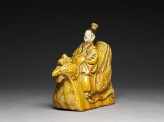Room 38 | China from AD 800 gallery
Explore key developments in the history and culture of China, from the arts and crafts of the Song Dynasty up to the present day.
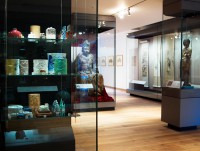
Religion, Philosophy and Environment
There have been three major religions during China’s history: Confucianism, Daoism and Buddhism.
Confucius lived some two and a half thousand years ago and his thought relates to public life and individual morality. Daoism, similarly old and also philosophical in its origins, is concerned with harmony and the spiritual in Nature. Buddhism was introduced from India in the first few centuries AD and has been widely practised as a popular religion.
The three systems were practised alongside each other with imperial rituals devoted to each. Confucian texts formed the basis of the education system and were central to political practice until the twentieth century. Daoism and Buddhism also endured, and early printed texts of both survive. Buddhism is evident in many works of painting and sculpture, as can be seen in those on display here.
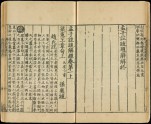 Opening from Exegeses on the Book of Mencius, with government imprint of AD 1201-1204, The works of Mencius (371-289 BC?) were important texts in Song Dynasty Neo-Confucian philosophy..
Opening from Exegeses on the Book of Mencius, with government imprint of AD 1201-1204, The works of Mencius (371-289 BC?) were important texts in Song Dynasty Neo-Confucian philosophy..
 Detail from the Diamond Sutra, a Buddhist teaching, written in Sanskrit c. AD 400, This Chinese translation is dated 868 and is over five metres long..
Detail from the Diamond Sutra, a Buddhist teaching, written in Sanskrit c. AD 400, This Chinese translation is dated 868 and is over five metres long..
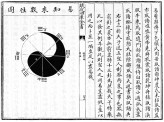 This diagram from a book published in 1613 shows the taiji (supreme ultimate) that represents the un.
This diagram from a book published in 1613 shows the taiji (supreme ultimate) that represents the un.
Buddhist figures
 Seated figure of a bodhisattva (EA1956.1376)
Seated figure of a bodhisattva (EA1956.1376)
 Standing figure of the bodhisattva Guanyin (EA1999.32)
Standing figure of the bodhisattva Guanyin (EA1999.32)
 Seated Buddhist figure (EA1999.40)
Seated Buddhist figure (EA1999.40)
 Dehua ware figure of the bodhisattva Guanyin (EA1956.3285)
Dehua ware figure of the bodhisattva Guanyin (EA1956.3285)
 Standing figure of the bodhisattva Guanyin (EA1961.151)
Standing figure of the bodhisattva Guanyin (EA1961.151)
 Seated figure of a bodhisattva (EA1971.18)
Seated figure of a bodhisattva (EA1971.18)
 Seated figure of the Buddhist disciple Lohan (EAX.1431)
Seated figure of the Buddhist disciple Lohan (EAX.1431)
 Fahua ware figure of a bodhisattva (EAX.1747)
Fahua ware figure of a bodhisattva (EAX.1747)
Temple sculpture
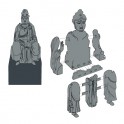 Sketch of seated figure of the bodhisattva Guanyin, 1200-1300, China (Museum no: EA1982.2) with part.
Sketch of seated figure of the bodhisattva Guanyin, 1200-1300, China (Museum no: EA1982.2) with part.
 Detail from mural painting of Wutaishan at Dunhuang (cave 61), Shanxi province.
Detail from mural painting of Wutaishan at Dunhuang (cave 61), Shanxi province.
Architectural ceramics
Notice
Objects may have since been removed or replaced from a gallery. Click into an individual object record to confirm whether or not an object is currently on display. Our object location data is usually updated on a monthly basis, so contact the Jameel Study Centre if you are planning to visit the museum to see a particular Eastern Art object.
© 2013 University of Oxford - Ashmolean Museum





